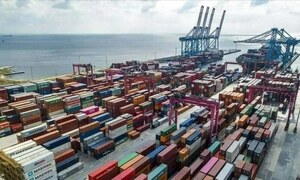The former Khyber-Pakhtunkhwa chief minister has claimed that the Kalabagh Dam could store up to 6.1 million acre feet of water during summer, shaving off floods peaks and releasing it during low-water months and increasing the availability of river water for use by the provinces as well as lowering flood peaks and providing floods relief.
Shamsul Mulk addressing a seminar arranged by the Pakistan Engineering Congress in connection with the World Water Day on Monday said the dam could generate up to 4,200 megawatts (about 12 billion units annually) of cheap electricity for national needs.
"For three provinces of Pakistan, alternatives for the dam exist. For KP, there is no alternative of the Kalabagh Dam; and this disparity is because of the location of the irrigable area where each province shall or can use its share of water for irrigation. The irrigable areas of the three provinces of the Punjab, Sindh and Balochistan are in the plains and thus easily commanded through gravity flow in the canals which receive their supplies from the various Barrages," he told his audience.
In case of KP, the former chairman of the Water and Power Development Authority said the land available and suitable for agriculture was about 800,000 million acres located in Bannu and DI Khan districts. "This land is in the form of plateaus at about 50 to 150 feet above the Indus River as it flows along the eastern boundaries of these districts. This will become relevant when another dam - the Bhasha Dam or any other is built and its stored water is distributed between the four provinces," he added.
He went on to say that while the Punjab, Sindh and Balochistan would have no problem in receiving its share, the share of KP would need to be raised by 50 to 150 feet to commend the irrigable area. "There are two ways to raise the Indus waters to those heights. One is to pump it ie lift irrigation. The other is to build the Kalabagh Dam, creating a reservoir that would raise water to a height easily commanding the plateaus and thus irrigate these lands by gravity. In this way, all the provinces would have the same equitable access to their share of water," he added.
Pakistan Engineering Congress President Chaudhry Ghulam Hussain said as a result of population growth, the surface water availability which was more than 5,000 cubic metres per capita in 1950, had now (2016) reduced to about 1,000 per person. "Pakistan is at the threshold of being a water-scarce country," he warned. He said, "Pakistan is mining about 50 million acre feet of ground water to meet the domestic agriculture demand. The current rate of ground water extraction is more than what is being recharged resulting in diminishing aquifer. If not regulated this would not be sustainable.
"Pakistan has the largest and the oldest contiguous irrigation system. After diversion of water at various barrages, 30 million acre feet of water on the average, goes down the last barrage into the Arabian Sea every year. The climate and freshwater systems are inter-connected in complex ways. Any change in one of these systems induces a change in the other.
"It is projected that there will be rise in temperature to the tune of four degrees Celsius by the end of current century in the Indus Plains. The impact of climate change on the snow and ice regimes of the Upper Indus Basin which provide more than 70 percent of the river runoff, also adds uncertainty to Pakistan water system. Water use, in particular irrigation water use, generally increases with temperature. If this be the case, then in Pakistan where water use is dominated by irrigation and accounts for more than 90 percent of total consumptive water use, we have to take pre-emptive measures to mitigate the negative impacts of climate change on water resources. Therefore, in order to have sustainable economic development, Pakistan must have more capacity to store water and make it optimal use."
He also said 30- to 35 million acre feet of water every year flowed into the sea over the years without any productive use in agricultural, generation of cheap electricity and industrial development. He went on, "Pakistan has only 30-day storage facility in dams compared to 220-day storage in India and 1,000 days in Egypt. According to International Standards, 40 percent of the river flows are required to be stored. Pakistan has only 13.29 million acre feet storage against 58 million acre feet, a dismal position.
"We have not spared even the ground water resources; one-million tube wells are extracting water, without any regulatory frame-work, and without adequate re-charge system which is resulting in steep fall in water tables. Hill torrents produce 18 million acre feet of water out of which 13 million acre feet can be used for bringing waste land under cultivation but no progress has been made resulting in flash floods and destructions during in the past six to seven decades."
BR100
11,841
Decreased By
-24.6 (-0.21%)
BR30
35,821
Increased By
124.3 (0.35%)
KSE100
113,789
Decreased By
-359.4 (-0.31%)
KSE30
35,833
Decreased By
-119.3 (-0.33%)

























Comments
Comments are closed.